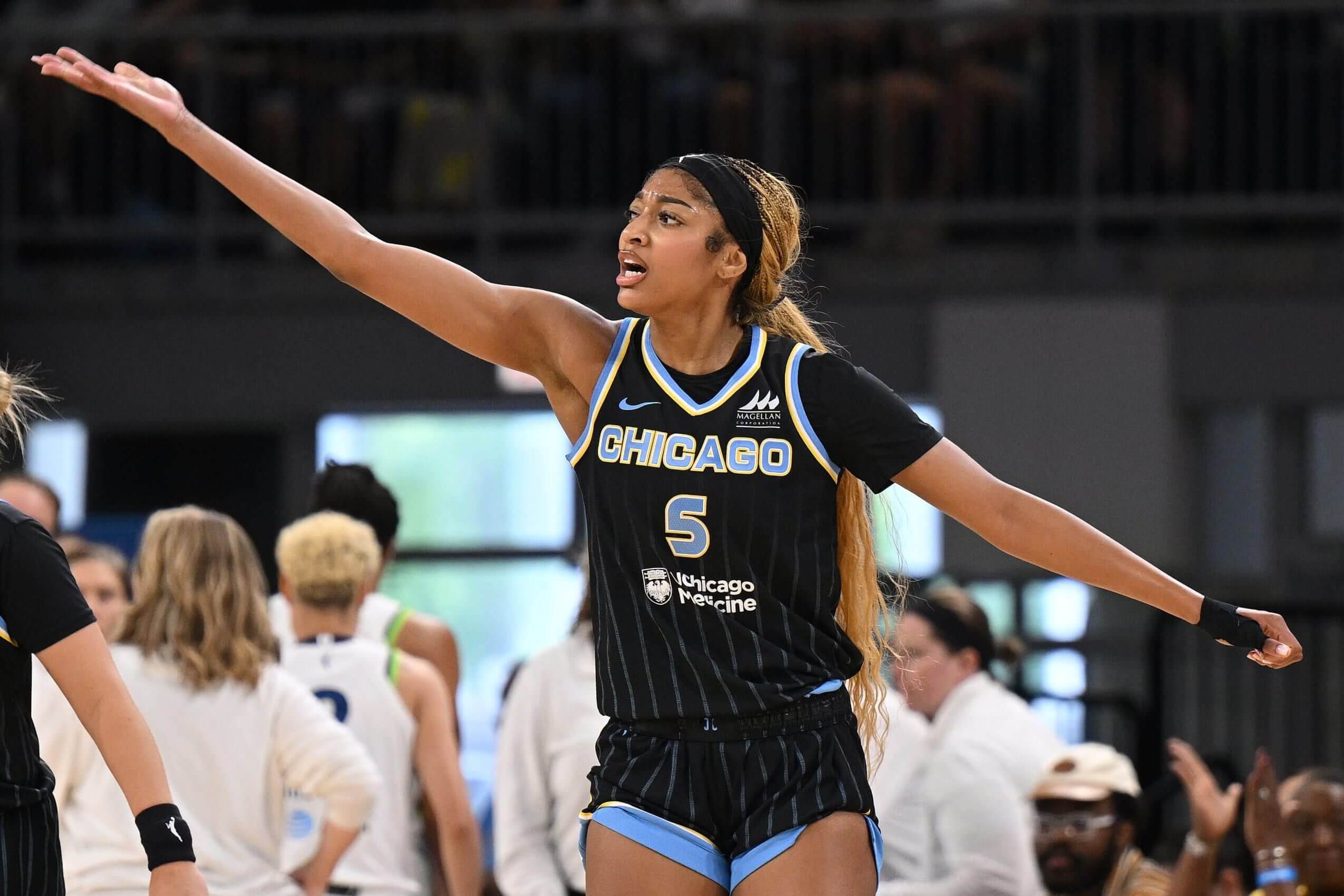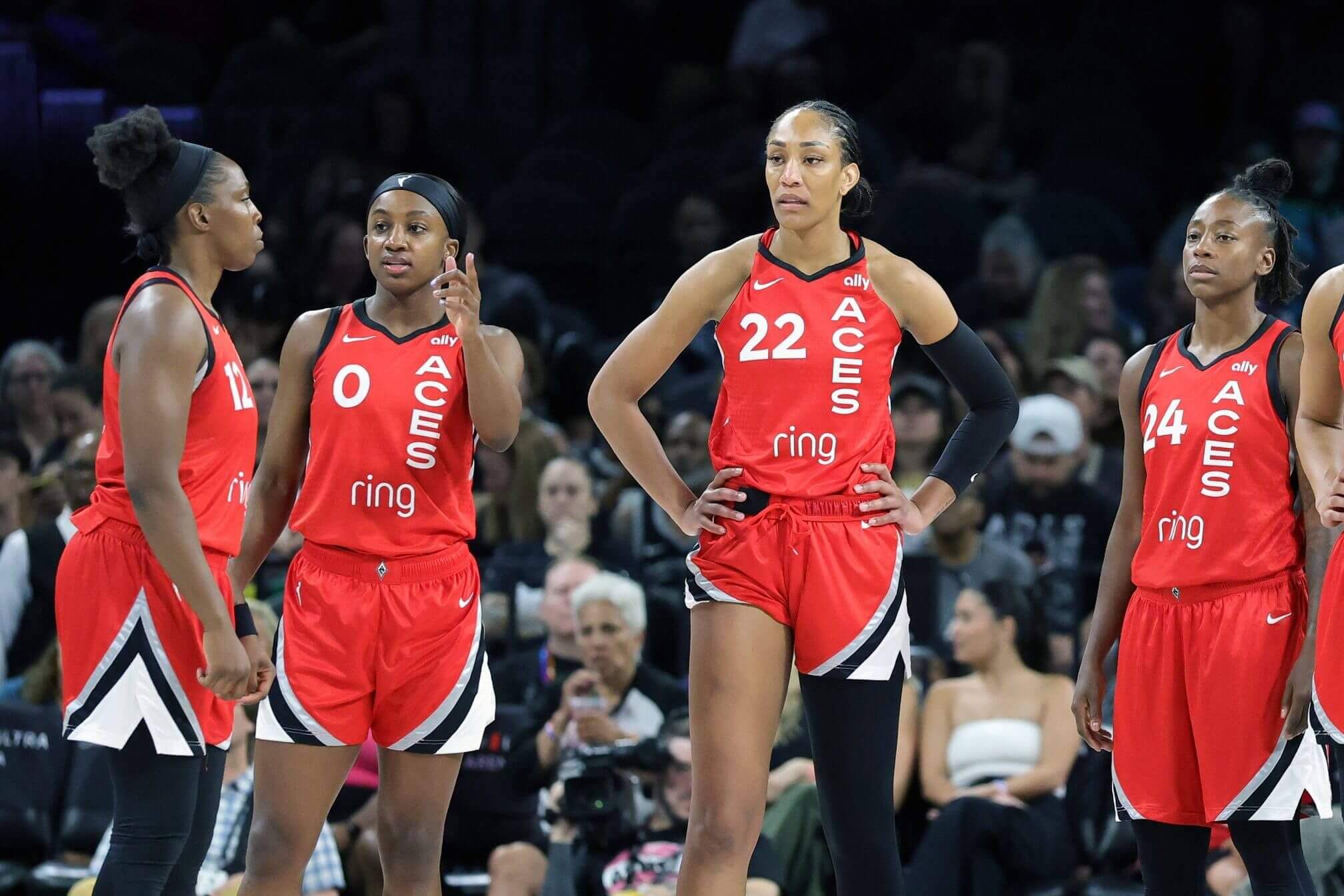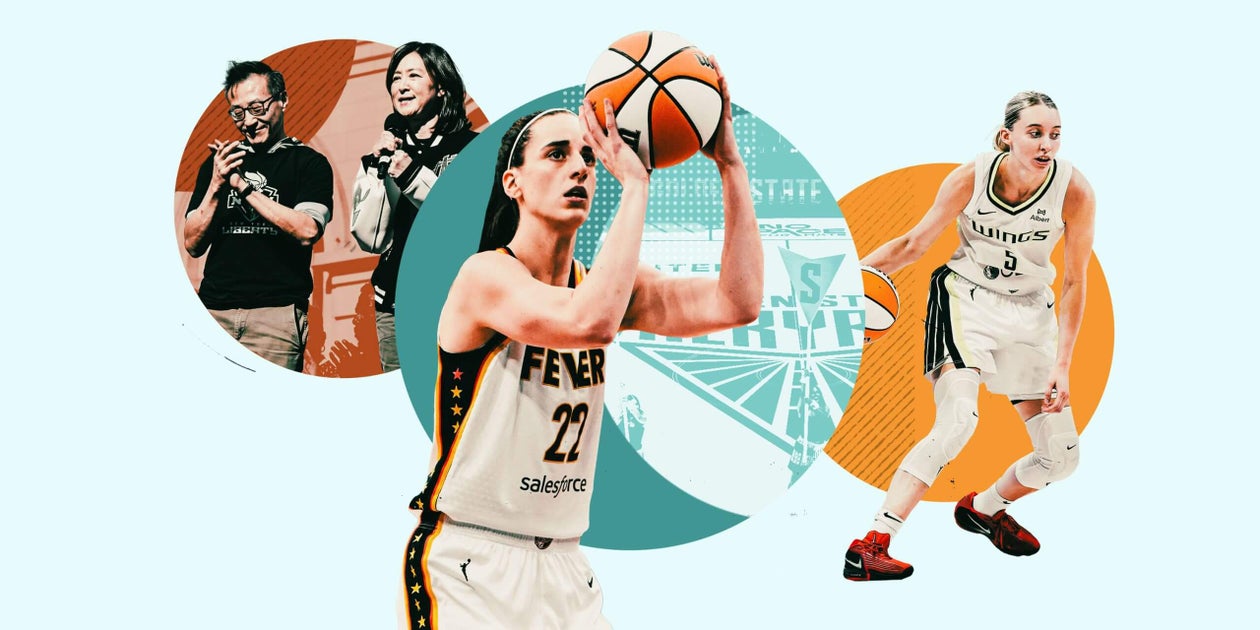The Minnesota Lynx, New York Liberty and Phoenix Mercury have all put themselves in position to win a WNBA championship this October because of their first-half performances. But present success doesn’t necessarily mean each will remain a contender over the next five seasons.
A lot can happen in that period, especially in the WNBA, where contracts are shorter, almost all league veterans are on expiring contracts, new facilities are under construction, and a new collective bargaining agreement looms. Front offices also will have to juggle at least four expansion drafts.
History has examples of the rapid shifts in the league: In the last five years, the Minnesota Lynx dynasty gave way to the rise of the Las Vegas Aces. The Indiana Fever have gone from a bottom-feeder, shuttling between Hinkle Fieldhouse and the Indiana Farmers Coliseum and their main arena, to one of the most popular franchises in sports. A veritable Mount Rushmore of WNBA greats — Sue Bird, Sylvia Fowles, Candace Parker and Diana Taurasi — retired.
So we wondered what the league might look like in another five years by ranking the 13 franchises’ futures.
Although the rankings are a useful snapshot of how teams are positioned in this moment, the particulars of a new collective bargaining agreement could upend the team-building process. Despite such uncertainty, The Athletic assessed which organizations are best built for future success. Through conversations with team officials and other league sources, we came up with five categories crucial to every franchise. We then assigned each of the categories a percentage value and ranked all 13 teams in each category.
Though most of the individual rankings required a degree of subjectivity, the overall score is a result of weighing the five categories as follows:
• Market size and attendance: 5 percent
• Front office and ownership: 30 percent
• Players: 35 percent
• Draft capital: 10 percent
• Facilities and amenities: 20 percent
Furthermore, this exercise does not include the five expansion teams set to debut in the WNBA by 2030. The performance of those teams will certainly affect the future of the existing 13, but there isn’t enough information about the incoming franchises to assess them now.
New York and Golden State — big markets with newer arenas — topped this list, while Dallas, Washington and Connecticut bring up the rear due to smaller arenas or less attractive destinations.
This category is purely objective. We ranked each team by its market size (i.e. the number of households in each WNBA city). We also ranked each team by its home attendance per game. Those totals were averaged to give a total market share score, with the tiebreaker decided by attendance.
Playing in a bigger market has an effect on players’ sponsorship opportunities. For instance, Jonquel Jones said in 2023 that she made more money off the court in one season in New York than seven seasons in Connecticut.
Another draw is playing in state-of-the-art arenas that create raucous fan environments. However, market and arena aren’t entirely predictive of team success. Las Vegas — which is second-smallest market in the WNBA — built a recent dynasty, and prominent free agents flocked to Atlanta, which has the smallest arena in the league, during the offseason. As such, this category only accounted for five percent of the overall formula.
There is an adage that ownership provides the greatest competitive advantage in professional sports. Employees can’t function without investment in an organization. But owners also have to empower the right people to run their teams, which is why this category ranks a combination of owners and front offices. A committed ownership group demonstrates its buy-in by building a staff and improving player experiences in every way possible, including player development coaches, training and support staff, analytics teams, housing and free-agency recruiting.
Despite not yet having a facility, New York tops this category because of an ace front office that has built a championship team, along with owners who have invested in everything else. Golden State and Phoenix similarly score high due to deep-pocketed owners and general managers who have made smart, if unheralded, moves in their short tenures.
Connecticut and Los Angeles are at the bottom because their owners don’t seem to prioritize their WNBA teams, and the front offices haven’t found the right mix of contending and planning for the future.
This is the heart of the exercise, as nothing determines a franchise’s success more than the players on the court. The category contributes 35 percent to the overall score. The bulk of this ranking is determined by each organization’s collection of young talent, identified as players 25 or younger who likely will still be under team control on a rookie contract. We prioritized players with All-Star and MVP upside.
About a third of the “players” score comes from the current veterans. We assume a large portion of players will remain with their teams; many of them are free agents only because of the projected rise in salaries, not because they want to leave. However, the uncertainty of the upcoming offseason — when all but two veterans will be free agents — forces us to more heavily weigh young players when making forward-looking evaluations.
Indiana wins this category on the strength of its All-Star duo of Caitlin Clark and Aliyah Boston, followed by Los Angeles, Washington, Dallas and Chicago, all of which have promising young stars. Teams with veteran All-Stars — Minnesota, New York, Phoenix and Las Vegas — but with fewer young prospects find themselves in the bottom half of this ranking.
The majority of WNBA champions are built around a homegrown No. 1 pick, or often around multiple top picks. The expansion of free agency threatens to change that, but for now, there is a premium on high draft picks, particularly the top selection in any draft.
As a result, the draft assets of a franchise factor into their future success. Given that these rankings project a five-year window, and the 2028-2030 draft picks are currently untouched, the two-year window of draft assets was worth 10 percent of our overall formula. The potential for a top pick was weighted higher than the total war chest an organization has accumulated. Seattle tops this category because it owns two potential lottery picks in 2026 (L.A. and Las Vegas). The Aces are at the bottom, after already trading away their first-rounder in the next two drafts.
When Las Vegas unveiled the first W-specific practice facility in 2023, it kicked off an arms race of organizations providing dedicated practice environments for players. Nneka Ogwumike said leaving Los Angeles for Seattle, which debuted a facility in 2024, added years to her career. Alyssa Thomas publicly castigated Connecticut’s practice set-up before joining Phoenix — which has the league’s newest facility — in the 2025 offseason.
Alyssa Thomas told @TheNextHoops that Mohegan has to do better in providing facilities for the Sun, who had to share a practice court the day before their first playoff game.
“To have to share your court with a two-year-olds birthday party, [it’s the] ultimate disrespect.” pic.twitter.com/FSIRAm1ooS
— Noa Dalzell 🏀 (@NoaDalzell) September 23, 2024
Players want a place to work on their game that also has treatment and recovery options. Players are increasingly prioritizing franchises that don’t put their teams in public gyms and force them to find their own places to work out in the offseason. We ranked teams by the quality of their facilities and also gave credit to those who have either broken ground on new facilities or have them planned in the near future.
Future franchise overall rankings1. Indiana
The Fever hold a slight edge in this exercise over the league’s other 12 teams. The duo of Caitlin Clark and Aliyah Boston lift Indiana to the No. 1 ranking in the player category (our most heavily-weighted section), and the Fever don’t rank lower than eighth in any of the four other categories. A new facility in 2027 should only make Indiana a more desirable place to play.
2. Golden State
It’s hard to imagine a better first half of the 2025 season for the Valkyries. They are hovering around .500 at the All-Star break, while leading the league in home attendance. Owner Joe Lacob wants Golden State to win a title in the next five years, and that goal doesn’t seem too lofty in reality. The Valkyries already have proven their front office is strong, and it’s coupled with an ownership group willing to invest. Their roster is deep, with a number of high-potential young players and facilities that will help them become one of the league’s most appealing teams.
3. Seattle
The Storm have transitioned from the Big 3 era of Sue Bird, Breanna Stewart and Jewell Loyd into another core with multiple All-Stars (Nneka Ogwumike, Skylar Diggins and Gabby Williams). Ogwumike and Diggins are unlikely to be members of the franchise in five years, but Seattle’s draft capital puts it in a position to remain competitive. The Storm also have a top-of-the-line practice facility and a resourceful ownership group.
4. New York
The 2024 WNBA champions are looking to maximize their window for as long as Breanna Stewart, Jonquel Jones and Sabrina Ionescu are leading the franchise. They have the league’s top front office and ownership combination, with top decision-makers who have a successful track record in investment and winning. New York is the league’s biggest market, and a new practice facility is in the works. Despite those factors, the Liberty aren’t higher in these rankings because this exercise takes into account age and contract statuses for veterans, and Jones and Stewart are in their early 30s.

The Mystics look like they can continue to add to their roster of young talent through the draft. (Mike Lawrence / NBAE via Getty Images)5. Washington
The Mystics’ future is bright mainly because of two aspects. Washington has the league’s deepest collection of 25-and-younger talent, with two All-Star rookies and multiple other cost-controlled players with future All-Star potential. Although the Mystics’ arena and amenities might be lacking in comparison, they also rank No. 2 in draft capital, owning Minnesota’s 2026 first-round and second-round selections and a 2027 first-round pick swap with the Chicago Sky.
6. Phoenix
Despite failing to advance past the first round of the playoffs since 2021, the Mercury have become an appealing destination and are well-positioned for future success. Phoenix ranks second in front office and ownership, and first in facilities and amenities. The Mercury are No. 12 in our players category, but that placement is largely due to the fact they are built around a veteran trio, each of whom has the ability to leave in free agency, with only two players under 26 on the roster.
7. Atlanta
The Dream are still trying to make the leap into the league’s upper echelon, and they find themselves placing in the middle of the pack in this exercise as well. They achieve the highest marks for front office and ownership, as general manager Dan Padover has demonstrated an ability to build competitive rosters, whether in his prior stint in Las Vegas or now with Atlanta. They also have an above-average combination of young players and veterans. The Dream currently rent their practice facility and are one of the few WNBA teams that didn’t started construction on a new complex or move into its own modern facility.
8. Minnesota
With star forward Napheesa Collier leading on the court and coach/president of basketball operations Cheryl Reeve leading on the sideline and in the front office, the Lynx are poised for success this season. This exercise, however, is forward looking, and Minnesota is dinged some for having a veteran roster on short-term contracts with few standout 25-and-younger options. A new ownership group is also now running the team, and though it seems to mostly want to leave the operation unchanged, how it impacts the Lynx is worth monitoring.

The Sky have a young star in Angel Reese but have other issues. (Daniel Bartel / Getty Images)9. Chicago
The recent string of success for forward Angel Reese should help elevate the Sky’s ceiling in future seasons. Questions, though, remain about the rest of the organization’s future. The Athletic’s anonymous player poll ranked Chicago as the worst-run organization. Although their ownership group appears to be investing more than ever, other teams still earn higher marks in that category, too. The young core beyond Reese also has question marks.
10. Dallas
Although the Wings have a potential future MVP candidate in rookie Paige Bueckers and are well-positioned to continue adding young contributors over the next two drafts, Dallas still lags behind some teams when comparing facilities and arena attendance. General manager Curt Miller was an executive of the year in Connecticut, but the Wings have had coaching instability in recent years, which makes predicting their future difficult. Dallas ranks relatively low, but little separates it from Chicago, Minnesota and Atlanta. Convincing cases could be made to re-order these four teams.
11. Los Angeles
Despite being under .500 yet again at the All-Star break, the Sparks still have one of the most appealing long-term roster outlooks. Second-year players Cameron Brink and Rickea Jackson will be central to future success, and the Sparks added veteran stars Kelsey Plum and Dearica Hamby in recent years. Despite all that as well as playing in a major market, Los Angeles lags because of how it measures in other metrics. The Sparks said in November that they are beginning to plan for a practice facility, but few public updates have been made about that project. Members of Sparks LA Sports, their ownership group, have invested handsomely in their other sports franchises, yet Los Angeles’ WNBA team has not received comparable investment. That plus a lack of draft picks limits its future output.

Roster questions loom in the Aces’ future. (Ethan Miller / Getty Images)12. Las Vegas
The Aces are less than two years past winning their second of two WNBA championships, but what is clear in the intervening years is just how much Las Vegas’ orbit revolves around star forward A’ja Wilson. Las Vegas ranks No. 13 in draft capital, after trading away its first-round picks in each of the next two years, and it still doesn’t have an official general manager. If Wilson and star guard Jackie Young re-sign next offseason, the Aces would improve their championship odds over the next five years. But in a forward-looking exercise, there is too much current roster uncertainty —what if either player leaves? — for them to net out any higher.
13. Connecticut
No franchise appears to have more overall uncertainty than the Sun, as all options are on the table related to their future. Perhaps the team will be sold and relocated, or perhaps a minority sale will occur and the franchise will remain in Connecticut. A lot could happen, and the Sun’s current facility will pale in comparison to its peers in future seasons if change isn’t made. Their arena attracts an engaged crowd when they are competitive, and the Sun recently renovated their locker rooms, but their front office remains unproven and their roster could see plenty of turnover in the future.
(Illustration: Kelsea Petersen / The Athletic; Icon Sportswire / Getty, Stacy Revere / Getty, Brian Fluharty / Getty, David Dow / Getty)

